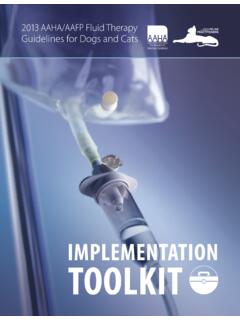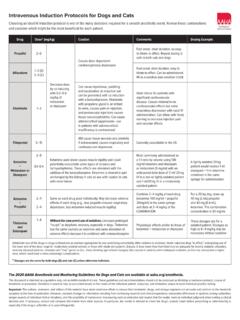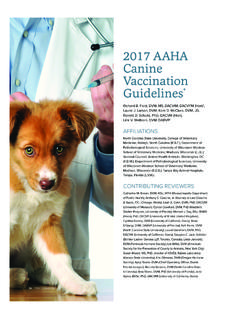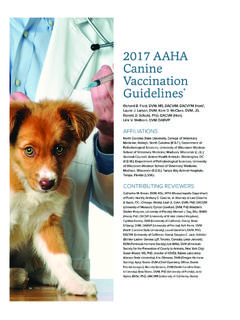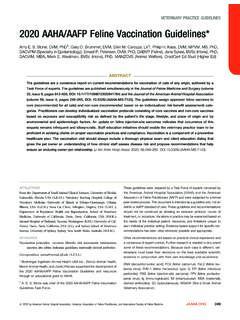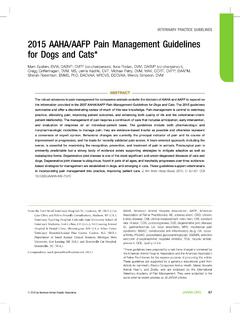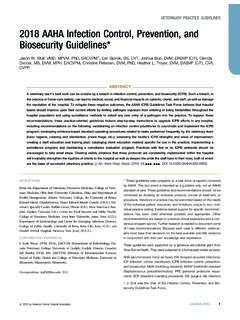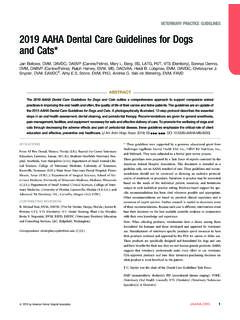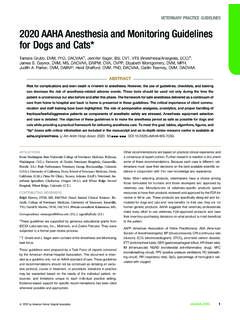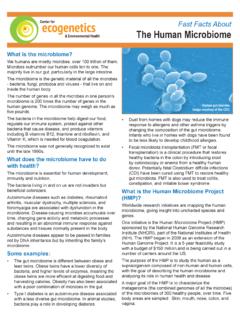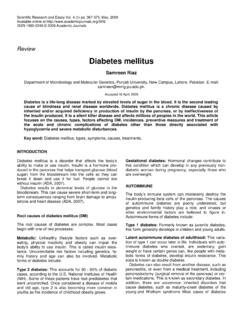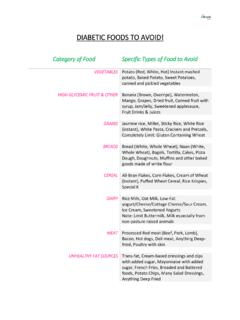Transcription of VETERINARY PRACTICE GUIDELINES 2018 AAHA Diabetes ...
1 VETERINARY PRACTICE GUIDELINES . 2018 AAHA Diabetes Management GUIDELINES for Dogs and Cats*. Ellen Behrend, VMD, PhD, DACVIM, Amy Holford, VMD, DACVIMy, Patty Lathan, VMD, DACVIM, Renee Rucinsky, DVM, DABVPy, Rhonda Schulman, DVM, DACVIM. ABSTRACT. Diabetes mellitus (DM) is a common disease encountered in canine and feline medicine. The 2018 AAHA Diabetes Management GUIDELINES for Dogs and Cats revise and update earlier GUIDELINES published in 2010. The 2018 GUIDELINES retain much of the information in the earlier GUIDELINES that continues to be applicable in clinical PRACTICE , along with new information that represents current expert opinion on controlling DM. An essential aspect of successful DM management is to ensure that the owner of a diabetic dog or cat is capable of administering insulin, recognizing the clinical signs of inadequately managed DM, and monitoring blood glucose levels at home, although this is ideal but not mandatory; all topics that are reviewed in the GUIDELINES .
2 Insulin therapy is the mainstay of treatment for clinical DM. The GUIDELINES provide recommendations for using each insulin formulation currently available for use in dogs and cats, the choice of which is generally based on ef cacy and duration of effect in the respective species. Also discussed are non-insulin therapeutic medications and dietary management. These treatment modalities, along with insulin therapy, give the practitioner an assortment of options for decreasing the clinical signs of DM while avoiding hypoglycemia, the two conditions that represent the de nition of a controlled diabetic. The GUIDELINES review identifying and monitoring patients at risk for developing DM, which are important for avoiding unnecessary insulin therapy in patients with transient hyperglycemia or mildly elevated blood glucose. (J Am Anim Hosp Assoc 2018; 54:1 21. DOI ). AFFILIATIONS is intended as a guideline only, not an AAHA standard of care.
3 From the Department of Clinical Sciences, College of VETERINARY Medicine, Auburn These GUIDELINES and recommendations should not be construed University, Auburn, Alabama ( ); Department of Small Animal Sciences, College as dictating an exclusive protocol, course of treatment, or proce- of VETERINARY Medicine, University of Tennessee, Knoxville, Tennessee ( ); De- dure. Variations in PRACTICE may be warranted based on the needs partment of Clinical Sciences, College of VETERINARY Medicine, Mississippi State of the individual patient, resources, and limitations unique to each University, Starkville, Mississippi ( ); Mid Atlantic Cat Hospital, Queenstown, individual PRACTICE setting. Evidence-based support for specific rec- Maryland ( ); and Animal Specialty Group, Los Angeles, California ( ). ommendations has been cited whenever possible and appropriate. Other recommendations are based on practical clinical experience CONTRIBUTING REVIEWERS and a consensus of expert opinion.
4 Further research is needed to Audrey Cook, BVM&S, MRCVS, DACVIM, DECVIM-CA, DABVP (Feline), document some of these recommendations. Because each case is Department of Small Animal Clinical Sciences, College of VETERINARY Medicine, different, veterinarians must base their decisions on the best avail- Texas A&M University, College Station, Texas; Lawren Durocher-Babek, able scientific evidence in conjunction with their own knowledge DVM, MS, DACVIM, Red Bank VETERINARY Hospital, Hillsborough, New Jersey. and experience. Correspondence: ( ); ( ) Note: When selecting products, veterinarians have a choice among those formulated for humans and those developed and approved by VETERINARY ALP (alkaline phosphatase); BG (blood glucose); BGC (blood glucose curve); BP. use. Manufacturers of VETERINARY -specific products spend resources to (blood pressure); CBC (complete blood count); DM ( Diabetes mellitus); HAC. have their products reviewed and approved by the FDA for canine or (hyperadrenocorticism); NPH (Neutral Protamine Hagedorn); PD (polydipsia).
5 Feline use. These products are specifically designed and formulated for PP (polyphagia); PU (polyuria); PZI (protamine zinc insulin); T4 (thyroxine);. dogs and cats and have benefits for their use; they are not human U (units); UG (urine glucose); UPC (urine protein:creatinine ratio). generic products. AAHA suggests that VETERINARY professionals make * These GUIDELINES were sponsored by a generous educational grant every effort to use VETERINARY FDA-approved products and base their from Boehringer Ingelheim Animal Health and Merck Animal Health. inventory-purchasing decisions on what product is most beneficial to They were subjected to a formal peer-review process. the patient. These GUIDELINES were prepared by a Task Force of experts con- A. Holford and R. Rucinsky were cochairs of the Diabetes Manage- vened by the American Animal Hospital Association. This document ment GUIDELINES Task Force. 2018 by American Animal Hospital Association 1.
6 Introduction infection, pancreatitis, and pregnancy/diestrus in both dogs and cats), or medications ( , steroids, progestins, cyclosporine). Ge- Diabetes mellitus (DM) is a treatable condition that requires a netics is a suspected risk factor, and certain breeds of dogs (Australian committed effort by veterinarian and client. Due to many factors that terriers, beagles, Samoyeds, keeshonden) and cats (Burmese, espe- affect the diabetic state, a pet's changing condition, and variable cially in Australia and Europe) are more ,7 Researchers response to therapy, management of DM is often complicated. continue to rede ne and reclassify the different etiologies respon- Success requires understanding of current scienti c evidence and sible for the development of DM in dogs and As different sound clinical judgment. Each patient requires an individualized etiologies become better understood, treatment can be more spe- treatment plan, frequent reassessment, and modi cation of that plan ci cally tailored to the individual patient.
7 Treatment that is more based on the patient's response. This document provides current speci c to the underlying etiology will presumably lead to better recommendations for the diagnosis, treatment, and management of control of clinical signs of DM and possibly increase remission rates. DM in dogs and cats. Regardless of the underlying etiology, classic clinical signs of Previous AAHA DM GUIDELINES published in 2010 are still polyuria (PU), polydipsia (PD), polyphagia (PP), and weight loss applicable and provide useful background for the 2017 result from protracted hyperglycemia and glucosuria. Increased fat Readers will note that the 2017 GUIDELINES use the same organizing mobilization leads to hepatic lipidosis, hepatomegaly, hypercholes- framework as the 2010 GUIDELINES . In some cases, essential content terolemia, hypertriglyceridemia, and increased catabolism. Eventu- from the earlier GUIDELINES has been retained verbatim.
8 Practitioners ally, if left untreated or inadequately controlled, ketonemia, will nd several items or topics in the updated DM GUIDELINES to be ketonuria, and ketoacidosis develop and result in progressive com- particularly relevant. These include: promise of the patient's health. Quick-reference algorithms on responding to hypoglycemia, It is important to differentiate patients with clinical DM from DM monitoring, and DM troubleshooting. those with transient hyperglycemia or mildly increased blood glucose New information on commercially available insulin formula- (BG). The subgroup of patients with mildly elevated BG but without tions and recommendations for their use in dogs and cats. concurrent clinical signs associated with higher levels of hypergly- Recommendations for home monitoring of DM, a disease cemia may require additional diagnostic and therapeutic measures management approach that can contribute substantially to a but not insulin therapy.
9 At this time, there is not a standard de nition favorable treatment response. for subclinical DM in VETERINARY medicine or any validated testing to Information on non-insulin therapeutic agents and treatment determine which patients are at risk for developing DM. In lieu of modalities such as dietary management. subclinical DM, the Task Force has elected to use the more de- The implications of identifying patients at risk for developing scriptive terminology patients at risk of developing DM, or simply DM and how to monitor and treat them. at-risk patients throughout the GUIDELINES . As potential new eti- Diabetes mellitus is a syndrome associated with protracted ologies emerge for overt or subclinical DM, they will be discussed in hyperglycemia due to loss or dysfunction of insulin secretion by future GUIDELINES or consensus statements. pancreatic beta cells, diminished insulin sensitivity in tissues, or both.
10 In the dog, beta-cell loss tends to be rapid and progressive, and is Diagnosis and Assessment usually due to immune-mediated destruction, vacuolar degeneration, These GUIDELINES describe different approaches to DM diagnosis and or Intact female dogs may be transiently or perma- assessment depending on the level of hyperglycemia and the presence nently diabetic due to the insulin-resistant effects of the diestrus of clinical signs. For cats and dogs who present with clinical signs phase. In the cat, loss or dysfunction of beta cells is the result of suggestive of DM, perform a physical exam and full laboratory insulin resistance, islet amyloidosis, or chronic lymphoplasmacytic evaluation (complete blood count [CBC]), chemistry with electro- Studies have shown that diabetic cats have remission lytes, urine analysis with culture, urine protein:creatinine ratio rates that have been reported to be variable (15 100%).
